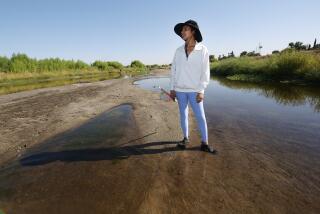Class IV in Session
Our instructions were to paddle out hard and stay to the left, and we had been darn good about following directions.
Mandy, our guide, had reason to be proud of her crew of neophyte rafters--five accountants, a sports editor and his wife.
Slaloming through an opening set of intermediate and advanced rapids on our maiden Whitewater voyage over the lower Kern River, we had stayed upright and were relatively dry.
Then came the challenge of relaunching our raft from a tie-in just below a particularly nasty stretch of water and boulders that had been declared unrunnable, even for experts.
The river, extra deep and running at twice the speed that rafters consider comfortable, battered us just as soon as we back-paddled away from the tie-in.
We got our raft turned down river, but we never made it to the calmer waters of the left bank.
No sooner had we straightened out than the front of the float raised up, nearly depositing Mandy and me--the paddlers at the stern--backward into the frothing current.
With our feet wedged securely under the seat in front of us, we both somehow managed to stay in the raft. It wasnât until we were able to steady ourselves again that we discovered three of our paddlers--everyone on the right side except for Mandy--were in the river.
Whistles blew, signaling to paddlers in four other rafts that we had âswimmersâ in the river.
Two of the paddlers were spotted immediately, their heads and the tops of their orange life jackets bobbing above the raging current. They were quickly scooped up to safety.
But the third was caught underneath our float, disoriented and out of breath. Finally able to break free, she emerged only to be tossed about in the churning white water, gasping for air.
My poor wife.
By the time Ronnie was pulled back into our raft, she was scared, pale and completely exhausted.
Later, at a stop for lunch, a guide from another raft recalled other paddlers who had suffered a similar fate.
âIâd counted to eight before, but this time I got to nine,â he said, smiling. âA new record.â
Nothing like a little gallows humor on the river.
*
Born from the snowy western slopes of mighty Mt. Whitney, the Kern River plunges through some of the most ruggedly beautiful terrain in central California.
Normally baked brown by this time of year, the surrounding Greenhorn Mountains are lush and sprinkled by wildflowers thanks to the rain, snow and cold from an unusually wet winter.
The river is generally described in three parts: the upper elevation Forks, which is surrounded by untamed wilderness; the Upper Kern, which runs parallel to Highway 178 below the Johnsondale Bridge and Fairview Dam; and the Lower Kern, which picks up below Lake Isabella.
All three stages are raging.
Chuck Richards, who runs one of the four commercial rafting operations on the Kern licensed by the U.S. Forest Service, says a water speed of between 1,500 and 2,000 cubic feet per second typically makes for a challenging yet enjoyable ride.
On our trip down the Lower Kern late in May, the speed was 3,802 cubic feet per second, a clip Richards, who has been running the river since 1975, compared to âriding a fire hose through the forest.â
The depth of the water, too, has changed hazard conditions all along the 55-mile river run. The 20-mile Lower Kern trip typically includes six class-IV (very difficult) rapids. On our voyage, there were nine.
Boulders that were easily maneuvered around during most years loom now as obstacles capable of stirring up teeth-jarring turbulence. And more water is on the way.
Rafting season on the Lower Kern normally runs from June through August; May into September during wet years.
This one started in March and is likely to last well into October. The snow pack in the mountains is 215% of normal. The water content is 280% of normal.
In 1983, a legendary year for white-water enthusiasts, the water content was about 250% of normal and the speed on the Lower Kern reached 7,000 cubic feet per second.
âIf it gets hot and stays hot, weâre going to have the biggest water weâve ever run,â Richards said. âItâs like the entire southern third of the Sierra Nevada is sitting up there in white, waiting to melt.â
Richards doesnât down play the danger of rafting trips. Where children 8 and up usually are allowed on the Lower Kern trip, he has taken to discouraging kids up to twice that age âunless they are surfers or are otherwise used to getting pounded by big water.â
Then again, anyone who has been half awake on the way up highway 178 on the way to Richardsâ office near the shore of Lake Isabella already knows something about the legendary âKiller Kern.â
Sobering signs are positioned at several locations:
âDanger. Stay out (no swimming). Stay alive. 195 lives lost in the Kern River since 1968.â
The â195â is on a changeable square, like the old scoreboard at Wrigley Field.
Richards despises those signs.
âWhere else do you go to a major recreation destination and upon arriving find a big sign that makes you wish you hadnât come in the first place?â he said.
What the signs donât tell visitors is that only a couple of the drowning victims were wearing life jackets. Most of the deaths, authorities say, were the result of recklessness. The only death on a commercial rafting trip was from a heart attack on shore.
Before our adventure started, Richards presided over a 20-minute lecture on safety. The recurring themes: Follow directions and respect the river.
âWeâll probably have swimmers today,â he warned, referring to rafters who have been dumped by the rapids, âbut thatâs routine to us. Weâll pick them up and get them right back into the boat.
âWhat gives us the willies is driving in freeway traffic in Los Angeles. How do you guys do that?â
*
Thereâs one in every crowd.
Ours was Dean Johnson, a tall, muscular Howie Long look-a-like from Fullerton.
Johnson, who signed up for the trip along with a few buddies, stated on several occasions that if our trip wasnât a âlife-threatening experienceâ he didnât want to go.
The guides just smiled and nodded.
J.R. Fearneyhough, in his second season on the river, was the guide on Johnsonâs raft.
The other guides considered that a perfect match.
After taking an earful from his thrill-seeking crew early in the trip, Fearneyhough intimated to the other guides that his passengers âmight be swimming a littleâ after our break for lunch.
Rapids are graded from I to VI. It has been said that a drunk on an inner tube is likely to survive a I, which might be compared to a swimming pool with a current. A VI is unpassable, even by an expert.
A IV is considered very difficult, and our trip would end after a stretch of five such rapids.
On one of them, appropriately named âHari-Kari,â Fearneyhough encouraged his crew to âfree footâ and not wedge their lower extremities in for stability. âBut that didnât really happen,â he said.
Next up was Horseshoe Falls, perhaps the most dynamic runnable rapid on the Lower Kern. There, Fearneyhough made sure it happened.
In the seconds before the raft took the first of three drops into the turbulent white-capped waves, the guide barked instructions to his crew to back-paddle, thereby killing the floatâs momentum.
âHorseshoe is one of those places that if you drop in there with no momentum youâre bound to get worked in one way, shape or form,â Fearneyhough said. âI wouldnât say I did that to them intentionally. Lets just say I wasnât surprised when we dumped.â
His crew was. âWe begged our guide to tip us over and as soon as we did we were like, âWhy in the hell did he allow us to do that?â â Johnson said.
Johnson sustained two cuts on his left hand trying to struggle back up to the surface.
Next up, after a stop to patch up Mr. Itâs Got To Be Life-threatening, was a class IV named Sidewinder, which is also known as Upper and Lower Bailmore or, by our guides, as âEat Rocks and Bleed.â
Fearneyhoughâs raft, now with six paddlers but only four paddles, drifted over to a spot in the rapid guides call the Kitty Box.
âYou donât want to go in the Kitty Box,â said Kevin Langley, another guide, âbecause, well, you know whatâs in there.â
For Johnson, it was his requisite life-threatening experience.
Entering the area backward, the float âdump truckedâ--guide slang for emptying the raft.
âWe wanted to go over again,â Johnson said, âbut when we did we were kind of upset. It was no longer fun. It was life-threatening at that point. We have one guy limping and I have a big, old knot on my knee. I can barely lift my leg.â
Fearneyhough just shrugged. âBailmore was not an intentional thing,â he said. âTheyâd had enough at Horseshoe, but the river hadnât had enough of them.â
*
By the end of our trip down the river, only a handful among the 25 paid rafters hadnât, at one time or another, âgone swimming.â And even if they hadnât, all had harrowing stories to tell.
âPeople will come in and say, âI want to run clean,â or, âGive me the best show of my life,â â Langley said. âThe trick, for 80% of the people, is they want to go big but they donât want to swim. Thatâs a very fine line, and sometimes you step over it.â
Johnson, safely off the river and changed into dry clothes, said he would be back to challenge the river again sometime soon.
âIt was great,â he said of his trip, âbut weâre going to go even bigger next time. We definitely want to go life-threatening . . . to a point.â
As for the Hisermans, weâd had enough of an adrenaline rush to last us a while.
But not forever.
âCall me crazy,â Ronnie said, âbut Iâd do it again.â
(BEGIN TEXT OF INFOBOX / INFOGRAPHIC)
WHO RAFTS THE RIVER
Chuck Richards Whitewater
P.O. Box W.W. Whitewater
Lake Isabella, CA 93240
(800) 624-5950
Kern River Tours
P.O. Box 3444
Lake Isabella, CA 93240
(800) 844-7238
Outdoor Adventures
P.O. Box 1149
Pt. Reyes Station, CA 94556
(800) 323-4234
Whitewater Voyages
5225 San Pablo Dam Rd.
El Sobante, CA 94803
(800) 488-7238
(BEGIN TEXT OF INFOBOX / INFOGRAPHIC)
RATING THE RAPIDS
* Class I (Simple): Mostly flat water; a swimming pool with a current.
* Class II (Moderate): Medium waves and current, minor obstacles. Straight lines, easy splashing and tame.
* Class III (Difficult): Longer, more powerful rapids. Maneuvering is necessary in heavy waves and around obstacles.
* Class IV (Very difficult): Steeper, longer drops. Looming, more complex obstacles require technical turns and precision movements.
* Class V (Expert): Violent and dangerous. Usually has big drops, powerful reversals and heavily obstructed channels.
* Class VI (Unrunnable): Even daredevil experts are at risk.
* P (Portage): Unrunnable. Rafts must be carried around such rapids.



